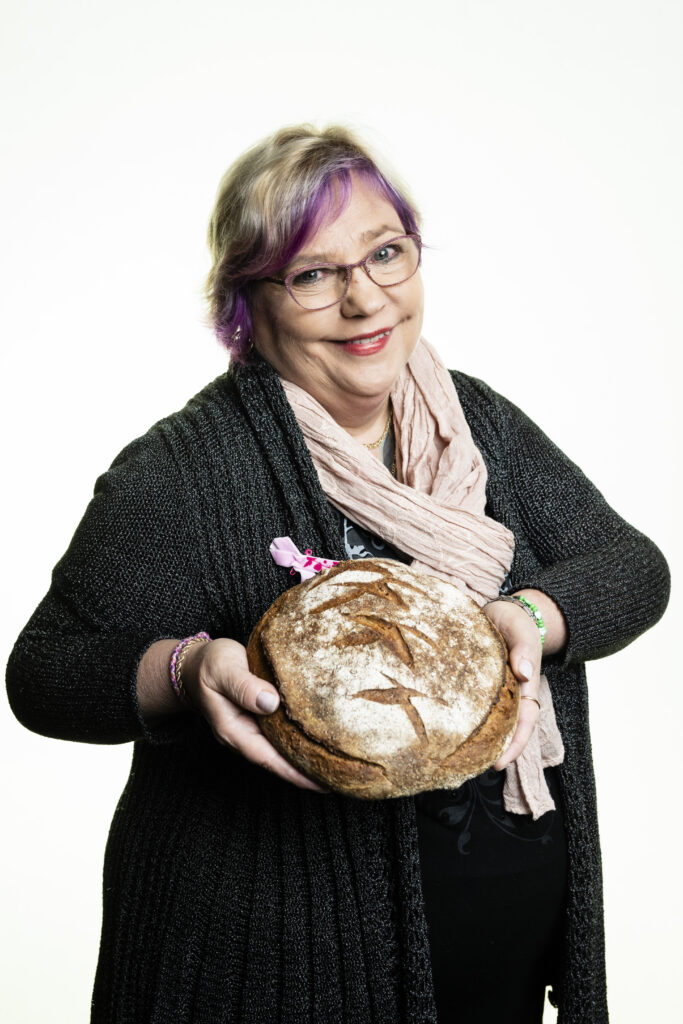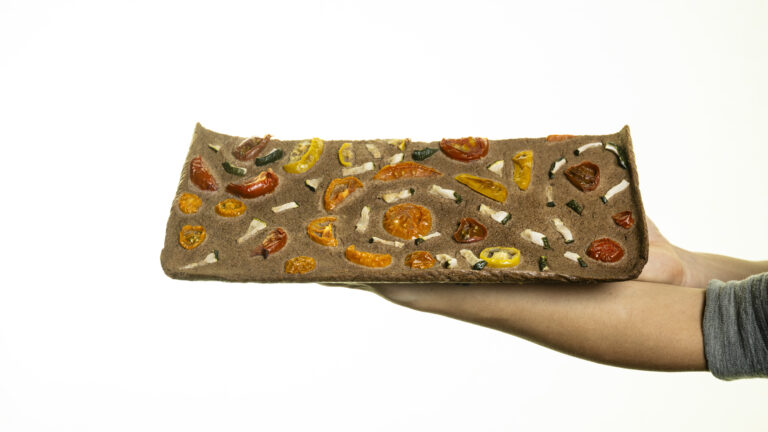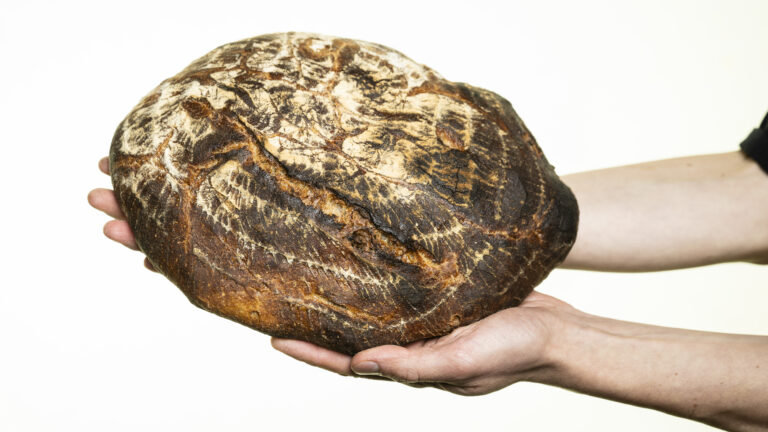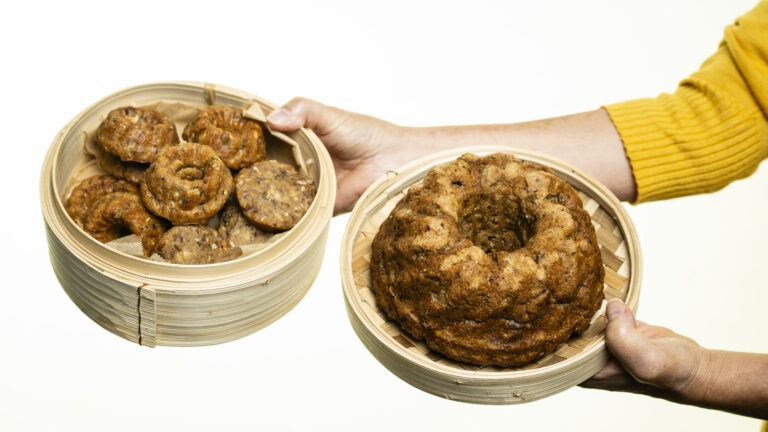Summer Spelt Bread
By Anne Kiuru (Kanta-Häme)
This rich blend of flours incorporates spelt, hemp and buckwheat. Spelt, an ancient grain, boasts a higher content of B vitamins, minerals, fat, fiber, and protein compared to conventional wheat. It is also easier to digest for those sensitive to gluten and requires 50% less nitrogen to grow.
Buckwheat flourishes in low-nutrient soils with minimal phosphorus, reducing the risk of nutrient runoff. Hemp, resilient to frost, is rich in protein and fiber and has exceptional carbon-sequestering properties. These flours are combined with nutrient-rich wild plants such as dandelions, fireweed, red and white clovers that naturally fix nitrogen in the soil, promoting healthy ecosystems.
The recipe is enhanced with naturally sweet medicinal honey and rapeseed oil, known for its high content of omega-3 fatty acids. Together, these ingredients contribute to ecological balance and rethinking land use policy by supporting regenerative farming practices, improving biodiversity, and reducing the need for chemical inputs, making this bread nutritious for both people and the soil.

photo: Veikko Somerpuro.
Ingredients
130 g active sourdough (spelt)
280 g water
460 g organic spelt flour (semi-coarse)
40 g organic buckwheat flour
10 g fine sea salt
1 dl dandelion petals (10 g) or 15 g chopped fireweed (rosebay willowherb) leaves or flowers, or 15 g white clover flower petals, or 15 g red clover petals
1 tbsp organic liquid honey
55 g (1 dl) of hulled hemp seeds
Rapeseed oil (for greasing)
Buckwheat flour (for the second shaping and dusting the basket)
For the starter:
65 g sourdough starter
65 g water
65 g organic spelt flour (semi-coarse)
Method
Start by renewing your sourdough starter. Mix the starter, water (at about 27°C), and flour together. Leave it at room temperature for about 2-4 hours until it becomes bubbly and mousse-like. The starter should have a pleasant, fresh smell and not be overly sour when it’s ready to use. Once the starter is ready, set aside the excess in a glass jar and store it in the fridge. It’s recommended to renew the starter weekly, even if you don’t bake every week.
For the bread dough, measure out the active sourdough, water, and flour into a bowl. Mix thoroughly and let the mixture rest, covered with cling film, for 1 hour. After the initial rest, knead the salt into the dough by hand. Once incorporated, add the remaining ingredients (including the dandelion petals or other optional floral ingredients, honey, and hulled hemp seeds) and continue kneading by hand until everything is well combined.
Grease a plastic container with rapeseed oil, place the dough inside, and cover it with a lid or cling film. Let the dough rise for about 2 hours. During this time, perform four sets of folds at 30-minute intervals. After the final fold, let the dough rise for an additional 30 minutes.
Once the dough has rested, lightly oil a baking tray and shape the dough into a round, flat ball. Cover the dough with cling film and let it rest for 30 minutes. Afterward, place the dough into a floured rising basket or a sieve with a baking tray underneath. Shape the dough again lightly with flour and place it back into the basket, bottom side up. Lightly flour the top of the loaf, cover it with a baking sheet, and place the entire basket into a plastic bag, loosely closed.
Refrigerate the dough overnight at a temperature below 4°C to allow it to slowly ferment and develop flavour. The next day, preheat your oven to 250°C, placing both a baking stone and an oven-proof bowl in the oven to heat up as well.
When the oven has reached temperature, take the dough out of the fridge and turn it out onto a floured bread board. Score the top of the loaf with two deeper cuts and make any desired decorative cuts. Carefully slide the bread onto the heated baking stone and pour 2 dl of boiling water into the oven-proof bowl to create steam.
Bake the bread at 250°C for 20 minutes. Then, reduce the oven temperature to 220°C and continue baking for another 20 minutes. Toward the end of baking, open the oven door twice to allow excess moisture to escape.
Once baked, take the bread out of the oven and check for doneness by tapping the bottom— it should sound hollow. Let the bread cool for at least an hour on a wire rack under a baking sheet. Enjoy the bread with a spread, such as a mixture of wild greens and margarine, or another preferred spread, seasoned with salt to taste.
Maaleipä Recipes

Acorn Flatbread
The Acorn Flatbread by Suvi Tiihonen from Keuruun Ekokylä contains leached acorns— a not very well known food from the forest—, buckwheat flour, zucchini and tomato.

Aune’s Zero Waste Herb Bread
Aune’s Zero Waste Herb Bread is baked in Japanese-style Yudane and reuses leftover roots and other vegetables with an incredibly rich variety of nuts seeds and herbs.

Gluten Free Hemp Buckwheat Bread
Merja Teräsvuori’s naturally gluten-free Hemb-buckwheat bread is made from a special combination of locally grown hemp flour, buckwheat flour, potatoes and an assortment of seeds.

Nettle Pancake Breadlet
Nettle Pancake Breadlet is Kirsi Hakonen’s honest oven top bread with nutritious nettle together with a rich mix of flours including—hemp, barley and spelt.

Wood Bread
Baked from pettu (pine bark) flour and flavoured with acorns, Jani Anders Purhonen’s fibre-rich Wood Bread celebrates the tradition of Pettu bread and takes a stand on the biodiversity of the farmland, using ingredients from the forest that could be a key part of our diet.

Round the Baltic Sea Caraway Cake
Anna Luttinen’s Round the Baltic Sea Caraway Cake contains spelt root, organically produced apples and zucchini, as well as caraway/cumin seeds—which are incredibly nutritious


